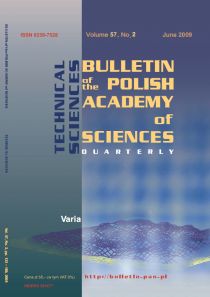POLISH ACADEMY of SCIENCES
TECHNICAL SCIENCES

| BULLETIN
of the
POLISH ACADEMY of SCIENCES TECHNICAL SCIENCES |
 |
|||
|---|---|---|---|---|
| Volume
59, Issue 2, June 2011
|
||||
| Issue Index | Authors Index | Scope Index | Web Info | |
|
|
||||
| Aims&Scope, Subscription | Editors | Authors' guide | to read PDF files | mirror: http://fluid.ippt.gov.pl/~bulletin/ |
| pp 247 - 252 |
|---|
|
Environmental evaluation with chemical sensors in the Palace Museum of Wilanow |
|---|
| J.PENA-POZA, M.GARCIA-HERAS , T.PALOMAR , A.LAUDY , E.MODZELEWSKA , and M.A.VILLEGAS |
| Environmental evaluation arises as an innovative procedure to carry out preventive conservation of Cultural Heritage items. Parameters contributing to the proper conservation of such items can be monitored and assessed. Chemical sensors with optical response synthesised by the sol-gel method are useful for a complete and accurate environmental evaluation. Physical-chemical mechanisms of decay and degradation of materials can be predicted from the sensors response, which will favour the decisions on the adequate procedures to avoid damage. Sol-gel sensors prepared and applied in the present work are reversible, reusable and regenerable. Their optical response provides a change of colour vs. the parameters to which they are sensitive. Both temperature and environmental acidity have been monitored in several selected chambers of the Palace Museum of Wilanów (Warsaw, Poland). The optical response of sensors was recorded by visible spectrophotometry from June 2010 to December 2010. The results inform on the environmental conservation conditions, both indoor and outdoor the Palace. Main innovation of the research carried out concerns the evaluation of the environmental acidity as an essential parameter to be taken into account for the proper conservation that can not be measured by conventional methods. |
| Key words: |
|
heritage, sensor, acidity, temperature, sol-gel, Wilanow |
|
|
| Issue Index | Authors Index | Scope Index | Web Info |
|---|---|---|---|
|
|
|||
| Aims&Scope, Subscription | Editors | Authors' guide | to read PDF files |
| Copyright ® Bulletin of the Polish Academy of Sciences: Technical Sciences |
|---|